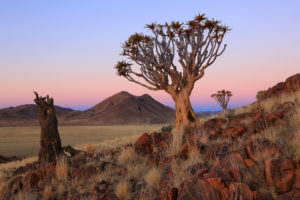
American Pika (Ochotona princeps) ©National Park Service
According to the latest estimates, nearly 400,000 people gathered in New York City this past Sunday to participate in the People’s Climate March. Thousands more took part in similar events in London, Paris, Istanbul, Jakarta, and other parts of the world. Photos of the massive turnout, timed to precede today’s UN Climate Summit, dominated yesterday’s news and social media feeds.
400,000 people. It’s an impressive number, and it does give me hope.
But as someone who just wrapped up an issue of a publication that explored the topic of climate-driven species movement, I wondered: how high would the count be if plants and animals had the ability to represent themselves at the People’s Climate March?

Quiver trees (Aloe dichotoma), living and dead, in Namibia.
Imagine hosts of Baird’s sparrows (Ammodramus bairdii), flying down Sixth Avenue, over the heads of the marchers, demonstrating their outrage over the recent projection that they will lose 100% of their breeding range by 2020 thanks to climate change. If Quiver trees (Aloe dichotoma) could uproot themselves from the deserts of Namibia and South Africa, surely they’d march on behalf of brethren who are dying at increasing rates in low elevations and areas closer to the equator. What if colonies of pika (Ochotona princeps) who have already disappeared from one-third of their previously known habitat because they cannot escape rising temperatures, skittered among the marching feet of protesters?

Landscape architect Michael Spina (2nd from L) at the People’s Climate March
My colleague, Michael Spina, was one of those protesters. After attending the march with his friends and family, he said, “we all took away a feeling of positivity and hope, which was palpable being surrounded by such a large powerful community of folks who are concerned about the environment.”
To Michael, and to all others who take action by participating in events like the People’s Climate March: thank you. Your “community” is larger than you can imagine.
Further Reading
Get to know Senior Engineering Technician Cody SmoutMeet Interdisciplinary Water Resources Engineer Emily Dubois
Get to Know Administrative Assistant Anne Berg
Jaye Hoyte Hayes reflects on his experience as a Biohabitats intern
Alyssa Burton’s experience as a Biohabitats intern
More From This Author
Thoughts on Natural CapitalThoughts on Earth Day
Get to know Sarah Emrich, Water Resources Engineer
Thoughts on Stakeholder Engagement
Thoughts on the San Francisco Bay Bioregion

